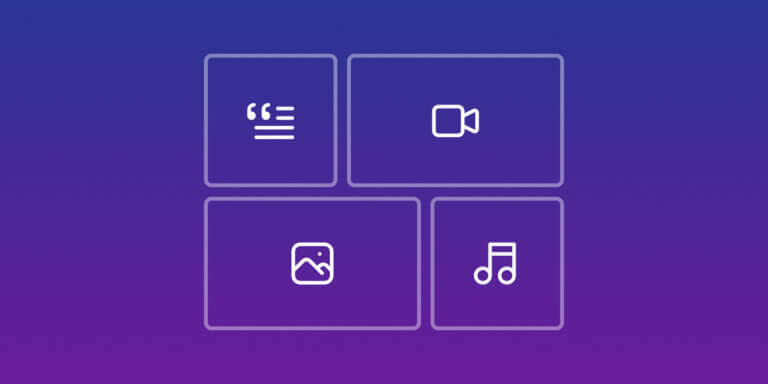Table of Contents
The online education market alone should generate US$203.81 billion [1] in revenue by next year, fueled by demand for online courses, ebooks, and videos, while new platforms like Patreon and LearnWorlds empower millions to earn through digital products.
I started selling digital content both as a side hustle and to grow a business. In all cases, my goal was always to share my knowledge and build a community first. The extra income was an extra nice-to-have that came when I nailed these.
So, in this guide on how to sell content online, I’ll show you how you can succeed in selling content online on multiple fronts.
What is digital content monetization?
Digital content monetization is simply the process that turns your online activity into an asset you can sell. Whether you have skills, knowledge, or entertainment to offer, there’s always someone out there who would pay for it.
The range of digital products you can create and make money out of them is enormous.
Ebooks, for example, are perfect for anyone with a story to tell or an idea to offer.
Ulyana from Mgroup Shopify Agency agrees:
Having interacted with Shopify merchants over a period of time, one of the digital products that has always provided consistent revenue streams is related to digital downloads such as ebooks, templates, or printables.
This is particularly true for markets that are tied to a particular niche with an audience that is willing to spend. For instance, some of our clients in the wellness, productivity, and education sectors have sold guided journals, digital planners, fitness plans, and budgeting spreadsheets.
Ulyana Shnitsar, Sales Manager & BDM at Mgroup Shopify Agency
Let’s also talk about templates.
Our Canva templates for social media are a best-seller, and they earn good revenue every month. These templates are popular because they are plug-and-play design tools, and non-designers can get graphics that look professional in a few minutes.
We created bundles with clear instructions and organized them by industry at checkout, with a value add-on. Customers rave about the combination of style and simplicity. Because they are digital and evergreen, we sell them with the understanding that they do not require updating, so they can be a consistent source of income throughout the whole year.
Marc Bishop, Director at Wytlabs
On top of these , online courses can cover virtually anything you want to teach, from yoga to Excel. I’ll talk about more examples in the next sections, but let me first clarify why you have no reason not to sell content online.
Benefits of selling digital content
For starters, costs are minimal.
No need to spend money on printing or shipping, and you don’t have inventory to worry about either. Once the product’s ready, you can run your entire business from your laptop (or phone).
Another big win is scalability and passive income. You won’t ever run out of digital products. You could be selling to one person or a million people, and you’ll use, more or less, the same resources.
And if we’re talking about a well-positioned system that takes care of digital marketing as well as delivery—such things do exist—then you’d be making money in your sleep. Literally.
Choosing the right platform based on your resources and goals
When I started selling content online, I relied on minimal resources. I only chose a platform to see my courses months after I started. To avoid this mistake, have a look at the following platform comparison to pick the one that suits your business model and goals from day one.
Let’s look at these in detail.
Self-hosted platforms
Platforms such as LearnWorlds, Sellfy, and Shopify allow you to build your own white-label shop where you decide on the layout and pricing. If you’re teaching a course, selling digital resources, or streaming videos, these platforms let you create the exact experience that you want.
The main perks? You can create a reputable online presence and gather more data on customers. The trade-off is that it’s going to require more work to set up and market your store. But if you’re willing to put in the work (or already have an audience/network), the creative freedom and potential for profit are worth it.
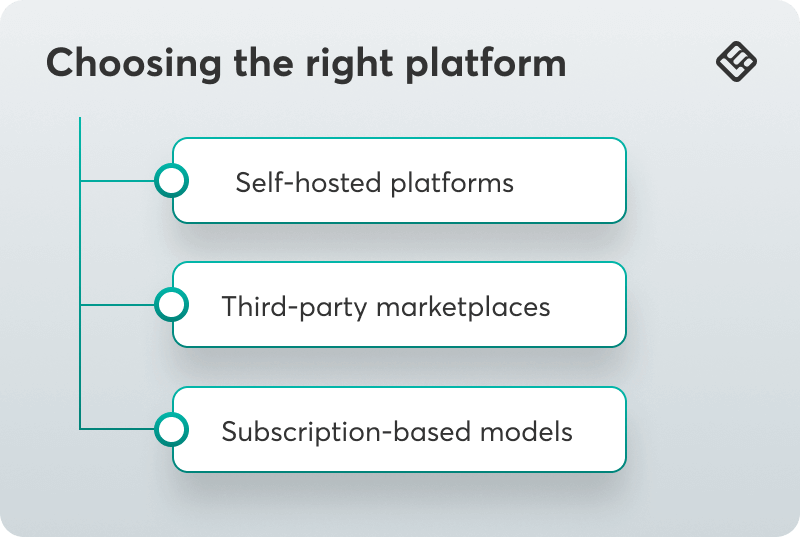
Third-party marketplaces
If you’re a beginner or if you just want a low-effort way to reach a large audience and focus on video creation instead, third-party marketplaces are a great pick to start selling videos and content.
If you’re a content creator, there are platforms like Etsy (for digital art and templates) and Amazon (for ebook and audiobook creators) that put you in front of millions of potential customers.
But you’ll lose some control and potential revenue for the sake of convenience. These kinds of platforms usually charge a percentage of your sales, and you’ll be yet another seller among many others to compete with.
Subscription-based models
If you’re creating ongoing content (think newsletters, podcast episodes, or exclusive videos), build your subscribers list with platforms like Patreon and Substack. These allow your fans to subscribe and pay a monthly fee for special access to you, premium content they can’t get anywhere else, behind-the-scenes updates, live streaming, or even one-on-one consulting calls.
Patreon has the most traction among artists, podcasters, and YouTubers who want to create a reliable community via video platforms, while Substack is the go-to choice for writers who want to monetize newsletters without constructing an entire website.
💡Read also: Top online course platforms: A comprehensive guide
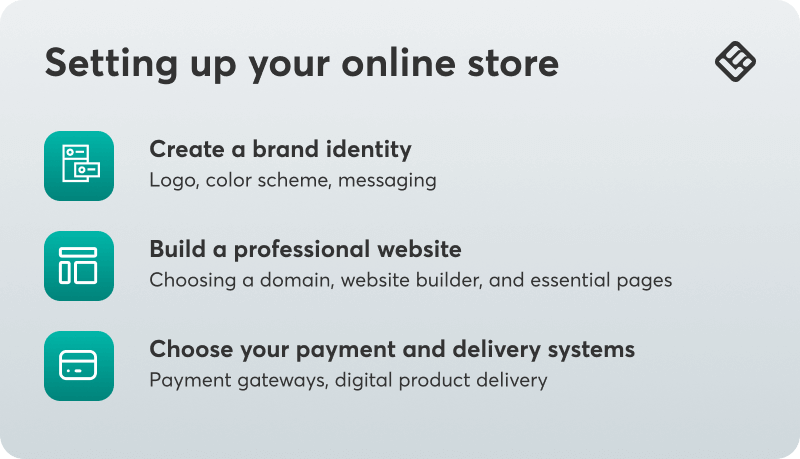
Setting up your online store for the first time
Once you’ve picked one of the best platforms, the next step is to build your online storefront.
Creating a brand identity
Before you start selling, you need a brand that gets people to want to know more about you and what you sell.
I didn’t do this early enough since I assumed these products would help me build that personal brand instead. But it’s your brand identity and personal messaging/positioning that help differentiate you and your content.
Do you want to be loud and fun? Or polished, steady? Keep your tone consistent across every platform.
Think of your brand as a character. The clearer you can get on who you are, the easier it is for people to connect with your message.
Building your own website and how to start selling digital products
For your own website, start with an easy-to-remember domain name that’s short and sweet. Pick a website builder that suits your needs without complicating your workflow.
Shopify works great for e-commerce, WordPress gives you an incredible amount of flexibility, and LearnWorlds comes with its own no-code website builder that makes it easy to get started instantly.
When it comes to its structure, add:
Note: You’ll need to look into a separate streaming service or video hosting platform like YouTube or Wistia to upload video files and share niche content that can promote the videos you want to sell.
Payment and delivery systems
Connect your website with payment gateways such as Stripe, PayPal, or Square to safely process payments and secure everyone’s online content delivery. Tools like Gumroad, LearnWorlds, and Shopify’s digital download apps automatically send your files and online videos to customers when payment clears. No manual emails, no lost downloads.
Marketing your content and how to sell videos online
Here comes with hard part: Promoting your content. I’ve prioritized the best strategies you can use below.
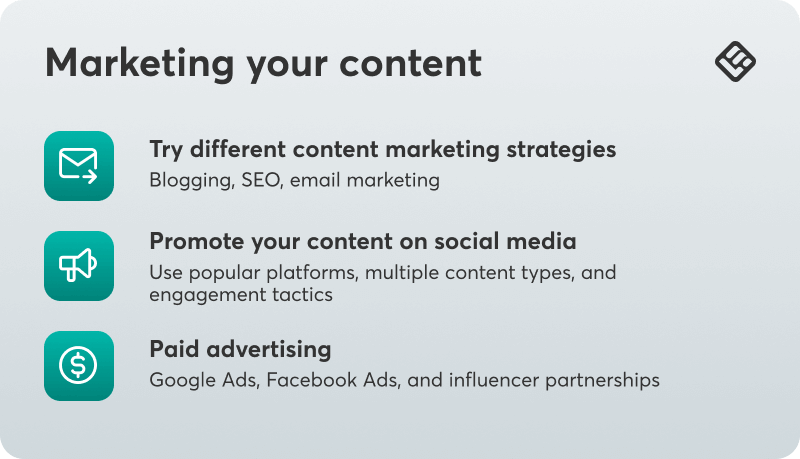
Content marketing strategies
I’m a content marketer myself, so I always start with content marketing as a primary strategy that’s both low-cost and effective. One of the best ways to achieve this is by blogging to rank better on search engines and bring in more people already looking for what you provide.
Don’t underestimate email marketing as part of your content strategy, though. It’s still the closest path you’ll get to having a direct line to your biggest fans.
Social media marketing
Social media remains a great tool for building your community. I personally rely heavily on a mix of content marketing and community building on my social channels and personal newsletter.
You shouldn’t be on all social media platforms. Only pick one or two where your main target market spends their time. Instagram and TikTok are great for video content, lifestyle, or community content. X is great for quick thoughts and updates. LinkedIn is best for professional content and educational or instructional videos if your target audience is in that space.
Mix and match these channels in your content strategy without overlooking any when you create content. YouTube videos, for instance, are a big revenue driver that many omit when they assume it takes more time to be on it.
I decided to create YouTube videos myself, but I opted to focus on a different niche than the one I portray on LinkedIn and X. This is because my main audience isn’t as active on YouTube, and the video website gave me the opportunity to share exclusive content.
Paid advertising opportunities
Once the organic part’s running well, you’ll want to look into paid ads. Platforms such as Google Ads and YouTube Ads allow you to target specific audiences through interest, behaviors, or even if they’ve visited certain websites.
The risk here is focusing too much on these classic ad channels. Depending on your target market, you’ll want to try advertising on unique platforms like Reddit or implement an influencer digital marketing strategy.
Note on how to make money selling digital products: Don’t forget that video creators can generate additional ad revenue besides selling video content online. Look into video monetization platforms to increase your income or use subscription video, premium videos, music videos, stock footage, and video on demand.
Legal and administrative considerations to be aware of
As a general best practice, I always work with a legal advisor and tax professional for anything going on behind the scenes of my digital business.
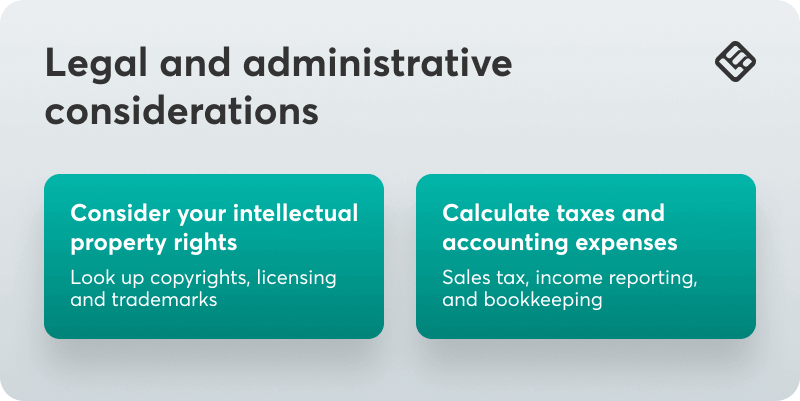
Intellectual property rights
With digital content, we’re also dealing with intellectual property that you have to defend. Your original work should be automatically copyrighted, and you have to control how it’s used.
So when it’s time to protect the elements of your brand (whether that’s your name, logo, or slogan), trademarks come in. Plus, if you want to let other people use your work, you need to set up clear licensing terms so that everyone knows what’s kosher and what’s not.
Taxes and accounting
When selling digital content, you’ll have to collect sales tax depending on the rules within your country or state. An accountant and accounting software help you keep track of every dollar without risking penalties.
Tips for growth and success
By now, we’ve barely covered the basics.
The most important part comes once you’ve started rolling out your content products. It’s now time to seek growth opportunities to expand your business.
Engaging with your audience
One of the best ways to expand your digital content business? Have actual conversations with the people you’re creating for.
I was only able to improve my content by listening and responding to comments, asking for more feedback, and being present.Use surveys, polls, or good old DMs to collect insights and refine your content or products.
After all, your objective isn’t just to construct an audience, it’s to build a community.
Continuous improvement
If you want one key takeaway, remember this: Success is all about constant improvement. See what resonates and what lands flat by checking up on your analytics tools regularly. Whether it’s blog traffic, email open rates, or product sales, those numbers speak.
Don’t stop updating your content and tracking trends as well. What worked last year may be obsolete today. Update your courses, revisit your old blog posts, and stay up to date on your design.
Ready to start selling your content online?
Whether you’re all about the freedom of a self-hosted option like LearnWorlds, the convenience of third-party marketplaces like Etsy, or the guaranteed income of a subscription model like Patreon, there’s a perfect strategy for selling content online that’s built just for you.
More importantly, you’ll want to select a system that works best for your content style, audience, and long-term business health.
LearnWorlds is an all-in-one platform for content creators looking to sell online courses, digital products, and create a community while having complete control of their brand.
Check out LearnWorlds now and start selling content online today!
Sources:
[1] Market insights & Online Education – Worldwide
Alexandra Cote
Alexandra Cote is a SaaS growth marketer and online instructor who's worked with dozens of brands in the MarTech, HR tech, and productivity space. She's also a strong supporter of staying happy at work and choosing a healthy career path.
FAQ
Everything you have ever wondered, but were too afraid to ask...



